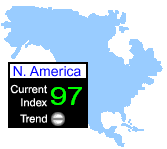Graphically speaking -- What NHC graphic to use?
"We're in the business of saving lives."
A certain movie
In the May 2007 Bulletin of the American Meteorological Society, Broad et al. (2007) served up an article entitled "Misinterpretations in the 'Cone of Uncertainty' in Florida during the 2004 Hurricane Season" (88 BAMS 651; article available for free). The article concerns the current National Hurricane Center graphic to use for public hurricane forecasts. To be clear, this isn't about what kinds of forecasts the NHC produces, but rather the form in which they are displayed in a publicly-consumable graphic. I highly encourage everyone to take a look at that article (it isn't very technical at all, so it is quite easy to follow).
The currently used graphic displays on a map the current storm position, its forecast track (with projected intensities), hurricane/tropical storm watches/warnings, and the 10 year forecast track error (the so-called "cone of uncertainty"). The authors claim (and I will not dispute their claim) that people pay too much attention to the forecast track of the storm without realizing that the effects of the storm are larger than just a dimensionless line and that the storm may deviate widely from the forecast track. Thus, these people do not prepare adequately (or at all!) for a potential or real threat. The authors suggest that the best way to alleviate this problem is to remove the track line, although the exact graphic they would endorse is unclear. Front line meteorologists have varying opinions about whether they think the track line should be included or not (some use it, some will remove it completely)--and this is very important since they have the job of communicating the NHC forecast (while TV meteorologists will deviate somewhat from the NHC forecast when there is significant evidence, especially in time-critical situations like landfall, they will generally stick to it to maintain uniformity so the public is not confused).
Generally speaking, my position would be that the public deserves all of the information they need to make an informed decision. But that's not really the correct viewpoint to take. The NHC's primary job is in saving lives (thus the opening quote), and doing what is necessary to get people who need to evacuate or take precautions to do so. If that means portraying information differently, than so be it. For example, the NHC will often shade the intensities of storms to a certain extent to maintain consistency, in order to keep the public from becoming confused (for example, if at 06Z the maximum winds are 75kt, then at 12Z the winds are 50kt, and then 75kt again at 18Z, it makes no sense to bounce from 75 to 50 to 75 again, which would simply confuse people). So the issue is which graphic will do the job of getting people to evacuate when necessary?
I don't disagree that people pay too much attention to the track line; in fact, I often pay too much attention to it. And in some ways, the 10 year forecast error also is abused too--the authors indicate that one storm out of three has direct impacts out of the error range (p. 654). At first blush, removing the line may be a good idea.
There is one problem though with removing the line. The idea of having the track line is to indicate the most likely track of the storm. Some storm forecasts have a much greater confidence than others in that track forecast (in many situations, it can often be a guess as to exactly where the storm will go). But removing the line and just having the error range almost makes it look like there's an equal probability that it could be anywhere in that zone. Sure, it would be reasonable to deduce that it would be in the middle, but people don't always make the most reasonable inference. So the people who are at the highest risk may not clearly perceive that. That's a serious problem--although this whole process is riddled with problems (overwarning versus underwarning is a concern--it's next to impossible to do things "just right", but that is what the public demands).
The question really should be not what the public wants to see, but what will most likely communicate the threat to them. I don't know the answer to this question, and unfortunately, the paper doesn't really tounch on this issue (beyond what isn't working). For example, I like some of the features of the new wind speed probabilities graphics (see last year's Alberto archive for examples), but I don't think that graphic is the answer. It only portrays one wind level per graphic, is underinclusive (it's good for shorter term, but doesn't really show longer term threats so well), and is ineffective at showing the strongest winds (the highest graph is a 64kt/74mph graph, so a hurricane with 135mph winds isn't going to be very clear, except in its large radius. But the current graphic doesn't really communicate this well either). The important question is how to make this issue clear to people--a question that doesn't seem to have an easy answer thus far.
METAR KRDU 090651Z 23505KT 10SM SCT250 24/20 A2992 RMK SLP126Labels: meteorology




